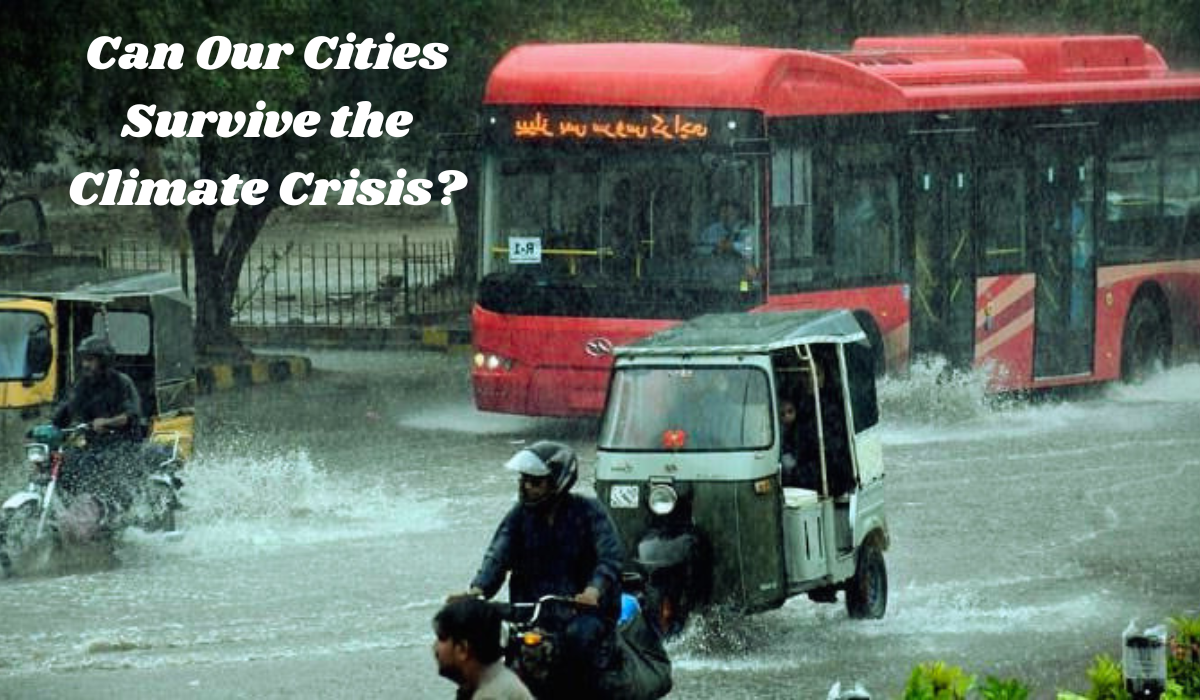Can Our Cities Survive the Climate Crisis 2024?

Overview
Our cities are facing a climate emergency. From intense floods to extreme heatwaves and severe droughts, we are on the front lines of climate change. This crisis is putting our urban areas under immense pressure, and it’s clear that we need to rethink how we build and manage our cities.
The Urgent Climate Crisis
- Frequent Disasters: Pakistan is regularly hit by natural disasters such as floods, heatwaves, and droughts.
- World Environment Day Reminder: The theme of ‘Generation Restoration’ on World Environment Day (June 5) reminds us of the need to tackle these challenges urgently.
Rapid Urbanization and Its Problems
- Fast Urban Growth: Cities in Pakistan are growing rapidly, with 38.8% of the population now living in urban areas, according to the 2023 Population and Housing Census.
- Poorly Planned Expansion: Much of this growth is unplanned, increasing the risk of climate-related disasters.
Shifting Flood Patterns
- From Riverine to Urban Flooding: The 2022 floods, which affected 33 million people, showed a shift from traditional river floods to urban flooding.
- Loss of Natural Spaces: Rapid urban growth often destroys natural floodplains and green spaces, making cities more vulnerable to floods, heat waves, and droughts.
The Role of Real Estate in the Crisis
- High Emissions: The global real estate sector contributes around 40% of total global emissions.
- Grey Infrastructure: In Pakistan, unchecked development has led to more buildings and roads, which replace natural landscapes and increase heat and flooding risks.
The Heatwave Challenge
- Rising Temperatures: In the summer of 2023, many Pakistani cities experienced temperatures above 45 degrees Celsius, making living conditions unbearable.
- 2024 Heatwaves: This year, temperatures have soared to 50 degrees Celsius in many parts of the country.
Frequent Urban Floods
- Predicted Floods: Models and satellite data predict that Pakistan may face extreme flooding again.
- Examples of Impact:
- Swat Floods: In 2022, floods submerged hotels and roads as the river returned to its natural course.
- Karachi Floods: Severe urban flooding affected even affluent neighborhoods, with water stagnating for long periods.
Encroachments on Natural Landscapes
- Twin Cities Example: Islamabad and Rawalpindi have seen significant encroachment on natural water streams like Soan, Korang, and Leh rivers.
- Impact: These encroachments worsen water quality and disrupt natural flows, increasing the risk of floods.
Pollution and River Degradation
- Waste Dumping: Housing societies and industries often dump waste into rivers, leading to severe pollution.
- Example: River Soan is heavily polluted due to sewage and industrial waste.
Soil Subsidence and Erosion
- Risks from Construction: Building along floodplains can weaken the soil, leading to issues like soil liquefaction, as seen in Joshimath, India.
- Local Impact: In Pakistan, similar risks are seen along riverbanks, with construction causing potential subsidence and infrastructure damage.
Global Climate Risk
- High Vulnerability: The Global Climate Risk Index ranks Pakistan among the top 10 countries most affected by extreme weather events.
The Heat Island Effect
- Shrinking Green Spaces: The loss of green areas makes cities heat islands, where concrete structures trap and radiate heat.
- Health Risks: This exacerbates the impact of rising temperatures and makes urban areas more uncomfortable and dangerous during heatwaves.
Generational Responsibility
- Past Priorities: Older generations prioritized rapid infrastructure development, often neglecting environmental sustainability.
- Youth Advocacy: Millennials and Generation Z are now advocating for sustainable practices and pushing for environmental priorities in development.
Steps Forward
- Urban Planning: Cities need better planning and integration of climate resilience into policies.
- Oversight and Accountability: The real estate sector needs stricter oversight to ensure environmental responsibility.
- Ecosystem Restoration: Removing illegal encroachments and rehabilitating degraded areas is crucial.
Community Engagement and Local Government
- Top-Down and Bottom-Up Approaches: Both approaches are needed to tackle climate challenges effectively.
- Community Involvement: Engaging local communities in planning and implementation is vital for success.
Climate Risk Insurance
- Promoting Resilience: Insurance policies can support investments in resilient infrastructure and sustainable practices.
- Safety Net: Insurance provides financial support for recovery after climate-related disasters.
The UN Living Indus Initiative
- Objective: This initiative aims to restore the ecological health of the Indus River and enhance climate resilience.
- Top Intervention: Focus on ‘green infrastructure for flood control and groundwater recharge’ to support urban resilience.
Environmental Education and Advocacy
- Empowering Youth: Younger generations must lead the charge for sustainability and influence policymaking.
Conclusion
- Collective Resolve Needed: To survive and thrive, cities must embrace urban resilience and environmental sustainability.
- Building for the Future: With determined action, we can create cities that not only withstand climate challenges but also flourish in harmony with nature.
About the Author
- Zainab Naeem heads the program on ecological sustainability and circular economy at the Sustainable Development Policy Institute (SDPI).
Table of Contents
This rewrite simplifies the language, organizes the information clearly, and highlights the critical points about the climate challenges facing urban areas in Pakistan.


